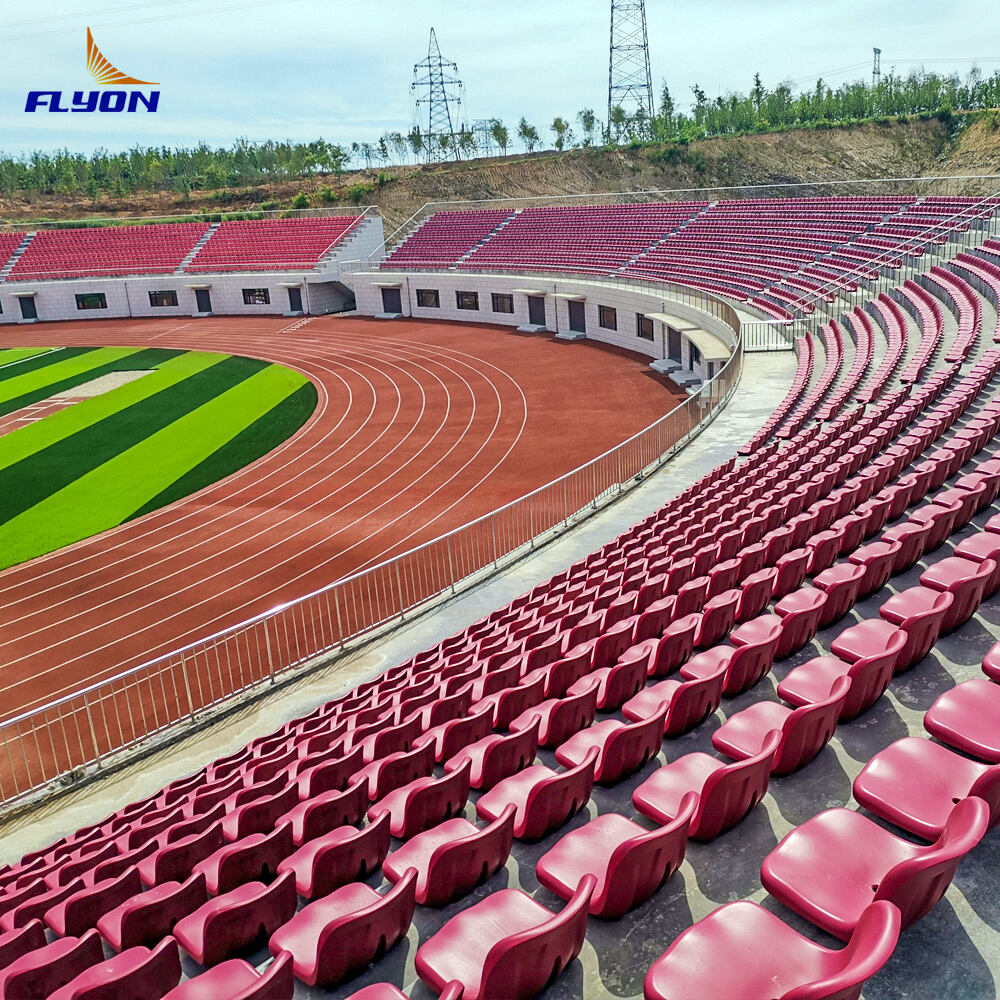The Impact of Stadium Seat Ergonomics on Fan Experience and Engagement
Ergonomic design principles in stadium seating and their impact on fan satisfaction
Stadium seats today are designed with three main comfort factors in mind. First, there's proper support for the lower back to keep spines aligned. Then we have seat angles that spread out body weight more evenly across the surface. And finally, manufacturers use materials that let air circulate better so fans don't get too hot sitting through long games. Studies on how people experience comfort in sports venues show something interesting too. Places that incorporate these design elements tend to hear about 28 percent fewer complaints from spectators who attend events lasting three hours or more compared to old school bleachers. Even just looking at the shape of the backrest makes a difference. Research simulations indicate that curved designs can cut down on lower back pain by around 19%, which matters when fans need to stay seated for extended periods.
How fan comfort during prolonged events influences overall engagement
Fans experiencing discomfort abandon their seats 43% more frequently to seek relief, missing critical gameplay moments and reducing crowd energy. Conversely, venues with ergonomic seating report 22% higher concession spending per capita, as attendees remain seated longer and participate more actively in communal cheering rituals.
Linking stadium seat ergonomics and spectator comfort to attendance trends
A 5-year analysis of MLB stadium renovations shows venues that upgraded to ergonomic seats increased season ticket renewals by 14% annually. Notably, 68% of surveyed fans cite seat comfort as a deciding factor when choosing between comparable sporting events.
Balancing seating capacity with ergonomic prioritization in stadium design
Leading stadium architects now achieve 15% density improvements without compromising comfort through:
| Design Strategy | Space Efficiency Gain | Comfort Metric Maintained |
|---|---|---|
| Slim-profile materials | 12% | Legroom width |
| Contoured armrests | 9% | Hip clearance |
| Tiered seating platforms | 18% | Sightline preservation |
This approach demonstrates ergonomic priorities can coexist with commercial objectives when supported by evidence-based space optimization techniques.
Seat Width, Legroom, and Row Spacing as Critical Factors in Stadium Seat Ergonomics
Getting stadium seating right means finding just the right balance between seat width, legroom, and how far apart each row sits so fans don't end up sore after three hours or more at a game. Studies show most people need around 18 to 20 inches across their hips to move comfortably, and about 12 to 14 inches deep before their knees start feeling cramped – numbers backed up by those heat maps tracking where folks sit during baseball matches according to the Venue Insights Report from last year. When it comes to stacking seats vertically, there's this magic number of 36 inches between rows that lets people lean back or stretch out legs without bumping into someone behind them. Pretty much every college football stadium that's been renovated recently follows this rule, with over eight out of ten NCAA Division I schools adopting it since early 2021.
Data-Driven Analysis of Optimal Legroom and Seat Depth for Long-Duration Events
Looking at survey results from over 42,000 spectators across three years reveals something interesting about stadium seating. Venues that offer at least 22 inches of legroom see fans taking standing breaks 41% less often than those stuck with just 18 inches of space between seats. The depth of the seats matters too. When Premier League clubs added temporary foam inserts to stretch seat depth from 14 to around 16.5 inches, complaints about back pain dropped by 32%, according to the Stadium Tech Journal from last year. And there's another trick up designers' sleeves: forward leaning seats angled between 9 and 12 degrees help people stay upright rather than slumping down throughout long games lasting well over 90 minutes.
Case Study: Improved Fan Retention After Legroom Optimization in NFL Stadiums
A major NFL venue increased offseason renewals by 18% after expanding lower-bowl legroom to 24 inches. Post-renovation tracking revealed:
| Metric | Pre-Renovation | Post-Renovation |
|---|---|---|
| Average time seated | 58 minutes | 83 minutes |
| Concession purchases | 1.2/person | 1.7/person |
| Early departures | 14% | 6% |
This aligns with broader findings that every 1-inch legroom increase correlates to 5% higher satisfaction scores in 3+ hour events (Fan Experience Consortium 2023).
Backrest Geometry and Spinal Support in Stadium Seating Design
Effective stadium seat ergonomics require meticulous attention to backrest geometry, as improper spinal alignment directly impacts fan comfort and engagement. Research shows that spectators experience 34% less lower-back pain during 3+ hour events when seating incorporates ergonomic lumbar support (Journal of Stadium Design, 2023).
Lumbar Support and Posture Maintenance Through Ergonomic Backrest Design
Stadiums these days are starting to include those curved backrest areas that actually fit most adult spines pretty well according to ISO 13406-2 guidelines. The new seat designs cut down on sideways bending by around 28% when compared to old fashioned flat seats, which helps people maintain better posture even after hours of sitting through games. And for top tier seating options, memory foam padding makes a big difference too. Studies show these inserts spread out pressure on the lower back area about 42% better than regular cushioning does. Makes sense why luxury sections command such high prices these days!
Ideal Angle and Curvature Standards for Backrests Promoting Spinal Alignment
Research suggests that the best backrest angle for comfort is somewhere around 100 to 105 degrees, with a small 15 degree curve at the lower back area near the L3 vertebra. This setup actually follows how our spines naturally bend when we sit properly, unlike those old stadium seats where people tend to slump forward because they're stuck at 90 degrees straight up. Another thing that makes these seats better is the slight forward tilt of the seat pan itself, usually between 4 and 7 degrees. This helps spread body weight more evenly across the surface, which studies from Ergonomics in Sports show can cut down on leg tiredness by almost 20%. Makes sense why so many sports venues are upgrading their seating now.
Fixed vs. Adjustable Backrests: Evaluating Effectiveness and Practicality in Public Venues
While adjustable backrests offer personalized comfort, fixed designs dominate professional stadiums due to 60% lower maintenance costs, 80% faster installation, and consistent sightline preservation. Hybrid solutions like zone-based angled sections (5° increments every 10 rows) provide ergonomic variety without compromising durability or sightlines.
Comparative Analysis of Backrest Performance Across Major Professional Stadiums
A 2023 benchmarking study of 12 NFL/NBA venues revealed:
| Design Feature | Top-Performing Stadiums | Comfort Improvement |
|---|---|---|
| Contoured Lumbar | 5/12 | 31% |
| Ventilated Backrests | 8/12 | 22% |
| Shock-Absorbing Mounts | 3/12 | 18% |
This data underscores how advanced ergonomic standards guide modern stadium design priorities without requiring complete seating system overhauls.
Advanced Materials and Thermal Management for Enhanced Seat Comfort
Innovations in cushioning materials for stadium seat ergonomics
Stadium seats these days come with high density foam padding that holds up year after year despite all the wear and tear, plus they offer good support for the lower back area where people tend to get sore. According to industry studies, places that have upgraded their seating materials see about a 22 percent drop in complaints from fans who sit through those long playoff games. Some newer seats even include temperature responsive gel inserts now. These gels change how firm the seat feels and help manage body heat depending on how long someone sits there and what the weather is like outside. Pretty clever stuff really when you think about it.
Thermal performance of seat materials during extended outdoor and indoor events
Mesh fabrics that let air through tend to dry sweat about 35 percent quicker compared to regular vinyl when tested under controlled conditions. Many outdoor spaces now use special PCM coatings on their seating areas. These materials can soak up around twice as much heat as normal coatings do, keeping seats cool enough at around 85 degrees Fahrenheit or lower even on hot summer afternoons. The sports world has really taken notice of this because nobody wants to sit on something that feels like a griddle during games played in July heat waves.
Ventilation and climate-responsive seating solutions in modern stadium designs
New seat designs are starting to feature holes in the base along with vertical air channels that cut down on heat buildup by around 25-30% compared to traditional solid seats. Some manufacturers have developed fabrics that actually trigger cooling mechanisms when built-in sensors pick up temperatures above 90 degrees Fahrenheit. These smart materials create comfortable spots right where people sit without needing extra air conditioning systems to run all day long. Stadium designers across the country are beginning to adopt these technologies, which means fans at both outdoor venues and indoor arenas can expect significantly better seating experiences during hot summer games and events.
Leveraging Fan Feedback to Drive Continuous Seating Improvements
Modern stadium designers increasingly treat spectator input as foundational data for iterative improvements in stadium seat ergonomics. A 2024 Fan Experience Report found venues using structured feedback programs reduced seat-related complaints by 43% while increasing season ticket renewals by 18%.
Using Fan Surveys and Behavioral Data to Refine Ergonomic Seating Features
QR code surveys after events give stadium designers insights they might otherwise miss. Take this MLS stadium that looked at around 12 thousand responses from fans last season. Nearly two thirds of them complained about back pain during those long three hour plus matches, which is why they completely redesigned their seatbacks. The numbers tell part of the story, but behavioral data brings things into focus too. Thermal imaging showed people were getting up and moving seats roughly every nine minutes throughout baseball games. Based on this observation, another stadium decided to switch out standard seating for breathable fabric with holes in it, letting air circulate better while folks watch the game.
| Feedback Source | Implementation Example | Result |
|---|---|---|
| Mobile app surveys | Added 1" seat depth extension | 34% fewer mid-game exits |
| Pressure mapping mats | Redesigned armrest curvature | 22% improved comfort scores |
Real-World Testing of Ergonomic Upgrades in High-Attendance Stadium Environments
Venues across the country are starting to test out different seating arrangements these days, often running small scale experiments to see what works best. Take one NFL stadium for example they tried expanding legroom space from 19 inches to 22 inches in just 5% of their seats. The results were pretty interesting folks sitting there spent about 28% more money at concessions stands because they simply felt more comfortable and stayed put longer during games. This kind of approach matters a lot especially for places that host everything from short concerts where people might only stay an hour or two to full day sports events where fans need to be seated comfortably for several hours straight. Getting this right helps operators maximize revenue while keeping audiences happy throughout the entire experience.
FAQs
Why is ergonomic design important for stadium seats?
Ergonomic design is crucial as it enhances fan comfort and engagement, reducing complaints and increasing attendance and spending.
What are the main factors in stadium seat ergonomics?
The main factors include seat width, legroom, row spacing, backrest geometry, materials, and thermal management, all contributing to fan comfort.
How do ergonomic seats impact fan spending?
Comfortable seating encourages fans to stay longer, leading to higher concession spending per capita.
What are the benefits of advanced materials in stadium seating?
Advanced materials provide better support, manage thermal comfort, and reduce wear and tear, enhancing the overall fan experience.
How do stadiums use fan feedback to improve seating?
Stadiums utilize fan surveys and behavioral data to refine seating designs, addressing common complaints and improving comfort.
Table of Contents
-
The Impact of Stadium Seat Ergonomics on Fan Experience and Engagement
- Ergonomic design principles in stadium seating and their impact on fan satisfaction
- How fan comfort during prolonged events influences overall engagement
- Linking stadium seat ergonomics and spectator comfort to attendance trends
- Balancing seating capacity with ergonomic prioritization in stadium design
- Seat Width, Legroom, and Row Spacing as Critical Factors in Stadium Seat Ergonomics
- Data-Driven Analysis of Optimal Legroom and Seat Depth for Long-Duration Events
- Case Study: Improved Fan Retention After Legroom Optimization in NFL Stadiums
-
Backrest Geometry and Spinal Support in Stadium Seating Design
- Lumbar Support and Posture Maintenance Through Ergonomic Backrest Design
- Ideal Angle and Curvature Standards for Backrests Promoting Spinal Alignment
- Fixed vs. Adjustable Backrests: Evaluating Effectiveness and Practicality in Public Venues
- Comparative Analysis of Backrest Performance Across Major Professional Stadiums
- Advanced Materials and Thermal Management for Enhanced Seat Comfort
- Leveraging Fan Feedback to Drive Continuous Seating Improvements
- FAQs
 EN
EN
 AR
AR
 FR
FR
 PT
PT
 RU
RU
 ES
ES
 BG
BG
 HR
HR
 CS
CS
 DA
DA
 NL
NL
 FI
FI
 DE
DE
 EL
EL
 HI
HI
 IT
IT
 JA
JA
 KO
KO
 NO
NO
 PL
PL
 RO
RO
 SV
SV
 CA
CA
 TL
TL
 ID
ID
 SR
SR
 SK
SK
 UK
UK
 VI
VI
 HU
HU
 TH
TH
 TR
TR
 MS
MS
 AZ
AZ
 KA
KA
 BN
BN
 LO
LO
 MN
MN
 MY
MY
 UZ
UZ


